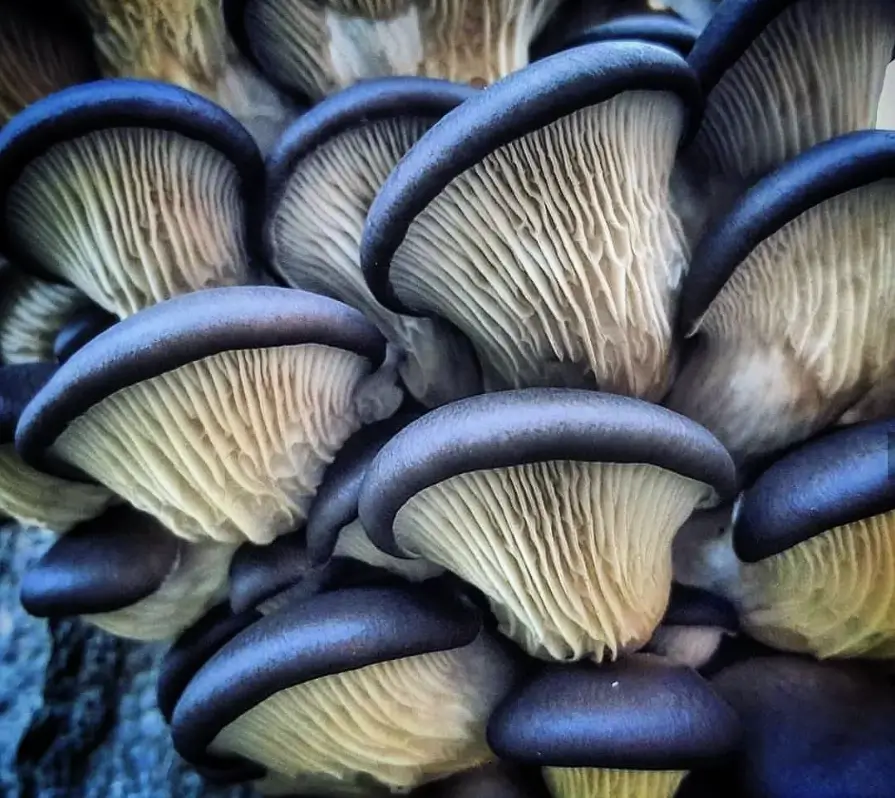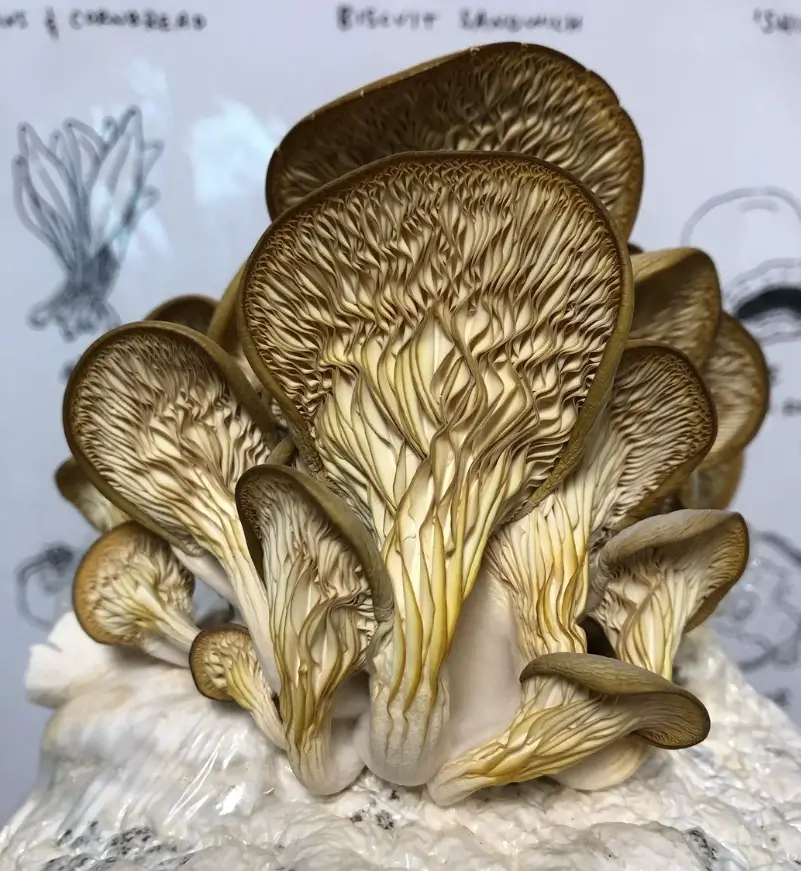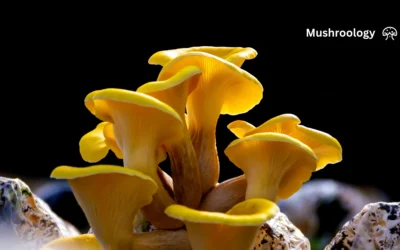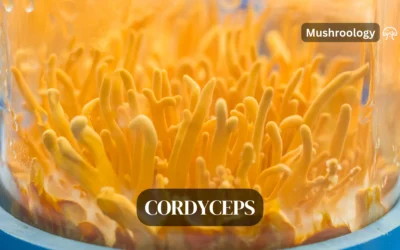Did you know that oyster mushrooms are one of the easiest and most popular varieties of edible fungi to cultivate at home? Not only are they delicious and nutritious, but they can also be grown indoors or outdoors with just a few simple steps. Get ready to enjoy a bountiful harvest of these delectable mushrooms in your home!
Where do oyster mushrooms grow?
Oyster mushrooms naturally grow on and near trees in subtropical and temperate forests throughout the world. As wood decomposers, they commonly form on logs and dead standing trees, particularly favoring deciduous trees like oak and beech. They prefer shaded areas in open, leafy woodlands.
In the wild, oyster mushrooms grow in clusters called “shelves” on rotting or fallen logs. They thrive in the shade, so they can often be found underneath fallen trees as well. While widespread globally, there are conflicting reports about their presence in the Pacific Northwest of North America – one source indicates they are not found there, while another mentions a variety called Pleurotus pulmonarius (lung oyster) that grows in that region.
Oyster mushrooms thrive under specific environmental conditions:
- Temperature: They grow best at temperatures between 15-25°C (59-77°F), though some sources suggest a slightly cooler range of 10-20°C (50-68°F)
- Humidity: Optimal humidity levels range from 85-90%, though they can grow in humidity as low as 55-70%
- Environment: They prefer dark, moist conditions
- Substrate: They can grow on various materials including straw, coffee grounds, and sawdust
Growing seasons of Oyster mushrooms
Oyster mushrooms have a relatively long growing season from spring to autumn. They particularly flourish during weather transitions, such as after the first frost. In hilly areas above 900m elevation, they grow best from March/April to September/October, while in lower regions their peak season is from September/October to March/April.
These mushrooms are popular for home cultivation because they’re not particularly picky about growing conditions compared to other mushroom varieties. They’re widely cultivated commercially throughout the world.
What are the Oyster Mushroom Growth Stages
Let’s explore their lifecycle in simple, science-backed terms.
1. Spore Germination: The Starting Point
Every oyster mushroom begins as a spore, a tiny reproductive cell similar to a plant seed. When spores land on a nutrient-rich surface like decaying wood or straw, they germinate in moist, warm conditions. This process produces hyphae—thin, root-like threads that spread through the substrate (growth material).
Fun Fact: A single mushroom can release millions of spores, but only a few find the perfect spot to grow!
2. Mycelium Development: Building the Network
The hyphae multiply and weave into a dense, white network called mycelium. This stage is like the mushroom’s “root system,” absorbing nutrients from the substrate. Mycelium thrives in darkness and can take 2–4 weeks to fully colonize the material.
Tip: Healthy mycelium smells earthy. If you see green or black spots, mold might be competing with your mushrooms.
3. Hyphal Knots: Baby Mushrooms Form
Once the substrate is fully colonized, the mycelium responds to changes in light, temperature, and airflow by forming hyphal knots[1]. These tiny bumps are the first visible sign that mushrooms are on the way.
Did You Know? Hyphal knots look like miniature cauliflower florets and signal the mycelium is ready to fruit.
4. Primordia (Pins): Mushrooms Take Shape
Hyphal knots grow into primordia, also called “pins”. These pinheads develop stems and caps, resembling tiny mushrooms. At this stage, maintaining 90–95% humidity is critical to prevent drying out.
Pro Tip: Mist the growing area regularly or use a humidifier to keep pins plump and healthy
5. Fruiting Body Development: Rapid Growth
Primordia mature into full fruiting bodies (the mushrooms we eat) in just 5–7 days. Caps expand, gills form underneath, and stems lengthen. Oyster mushrooms grow best at 60–80°F (15–27°C) with indirect light[.
Fun Fact: Oysters double in size daily during this phase—one of nature’s fastest growth spurts!
6. Spore Release: Completing the Cycle
Mature mushrooms release spores from their gills, restarting the lifecycle. While spores are harmless, some growers harvest mushrooms just before this stage to avoid messy spore drops.
Choose the right Oyster mushroom variety

When it comes to growing oyster mushrooms at home, there are several different varieties to choose from. Each variety has its own unique characteristics and growing requirements. Let’s explore some popular oyster mushroom varieties:
Pearl Oyster Mushroom
The pearl oyster mushroom (Pleurotus ostreatus) is one of the most commonly cultivated oyster mushroom varieties. It has a delicate flavor and a beautiful, pearl-like appearance. This variety is versatile and can be used in a variety of dishes.
Blue Oyster Mushroom
The blue oyster mushroom (Pleurotus ostreatus var. columbinus) gets its name from its striking blue color. It has a mild, nutty flavor and a firm texture. It’s a visually stunning addition to any culinary creation.
Golden Oyster Mushroom
The golden oyster mushroom (Pleurotus citrinopileatus) is known for its vibrant golden-yellow color. It has a strong, slightly peppery flavor and a delicate texture. This variety is perfect for adding a pop of color to your dishes.
Pink Oyster Mushroom
The pink oyster mushroom (Pleurotus djamor) is prized for its vibrant pink hue. It has a sweet, fruity aroma and a tender, meaty texture. This variety adds a fun and unique touch to any dish.
Phoenix Oyster Mushroom
The phoenix oyster mushroom (Pleurotus pulmonarius) is often referred to as the “summer oyster.” It has a slightly more robust flavor compared to other oyster mushroom varieties. Its creamy-white caps and short stems make it visually appealing.
King Oyster Mushroom
The king oyster mushroom (Pleurotus eryngii) is known for its large size and meaty texture. It has a rich, earthy flavor that intensifies when cooked. This variety is a favorite among chefs and home cooks alike.
When selecting an oyster mushroom variety to grow at home, consider your preferences in terms of flavor, appearance, and texture. Additionally, take into account the specific growing requirements of each variety to ensure successful cultivation.
Creating the Ideal Growing Environment
Oyster mushrooms are highly adaptable fungi that require specific environmental conditions to thrive. By creating the perfect growing environment, you can ensure a successful oyster mushroom cultivation journey right in the comfort of your own home.
The Ideal Temperature for Oyster Mushroom Cultivation
Oyster mushrooms prefer temperatures ranging from 50-86°F (10-30°C). However, it’s important to note that different varieties may have specific temperature preferences. For example, the king oyster mushroom variety thrives in slightly cooler temperatures around 45-65°F (7-18°C).
Optimal Humidity Levels for Successful Cultivation
Humidity plays a critical role in oyster mushroom cultivation. Maintaining humidity levels between 85-95% is essential for their growth and development. You can achieve this by misting the growing area regularly or using a humidifier to maintain the ideal moisture levels.
Control the airflow for healthy oyster mushrooms
Adequate airflow is vital for preventing the stagnation of air and the build-up of carbon dioxide around your oyster mushroom growing area. Ensure proper ventilation by using fans or opening windows to allow fresh air circulation. This helps promote healthy mushroom development and prevents the growth of molds or other unwanted organisms.
FUNGI FACT: Oyster mushrooms thrive in humid conditions due to their natural habitat in forests, where the air is moist and rich in decaying organic matter.
| Growing Condition | Ideal Range | Variety-Specific Range (e.g., King Oyster Mushrooms) |
|---|---|---|
| Temperature | 50-86°F (10-30°C) | 45-65°F (7-18°C) |
| Humidity | 85-95% | N/A |
| Airflow | Adequate ventilation | N/A |
Choosing the Right Growing Substrate

The substrate is a critical component when it comes to cultivating oyster mushrooms at home. While straw is the most common substrate for oyster mushrooms, there are other options available that can yield equally successful results. You can experiment with materials such as coffee grounds, sawdust, or cardboard to find the best fit for your growing setup. The choice of substrate depends on factors like availability, ease of preparation, and the specific requirements of the oyster mushroom variety you intend to grow.
Straw as a Substrate for Oyster Mushrooms
Straw is widely used as a substrate for oyster mushrooms due to its favourable characteristics. It is readily available, affordable, and relatively easy to prepare. Wheat, barley, or rye straw are commonly used, but oat and rice straw can also be suitable choices. The straw needs to be properly hydrated before use, usually by soaking it in water for a few hours or overnight. After hydration, the excess water should be drained to achieve the ideal moisture content.
Alternative Substrates for Oyster Mushrooms
If straw is not readily available or you want to explore different substrates, alternative options can be used successfully for growing oyster mushrooms. Coffee grounds, for example, are a popular choice as they provide a rich source of nutrients and are often easily accessible. Sawdust, particularly hardwood sawdust, can also be used as a substrate for oyster mushrooms. It is important to ensure the sawdust is free from contaminants and properly sterilized before use. Additionally, cardboard can be used, but it should be shredded and soaked in water to break it down and facilitate the growth of mycelium.
“Choosing the right substrate is crucial for the successful cultivation of oyster mushrooms. Experimenting with different materials like coffee grounds, sawdust, or shredded cardboard can help you find the best substrate for your specific growing conditions.”
Remember, each substrate has its own advantages and disadvantages, and the choice ultimately depends on what works best for your resources and preferences. By selecting the right growing medium, you can create an ideal environment for the mycelium to thrive and produce a bountiful harvest of oyster mushrooms.
Inoculating the Substrate with Mushroom Spawn
To initiate the growth of oyster mushrooms, you will need to inoculate the substrate with mushroom spawn. Mushroom spawn is a mixture of mycelium and a nutrient-rich material. You can purchase oyster mushroom spawn from reputable suppliers or even make your own using a sterilized substrate. The spawn is then mixed with the substrate in a clean and sterile environment to encourage the growth of oyster mushroom mycelium.
Inoculation is a crucial step in oyster mushroom cultivation as it introduces the mycelium into the substrate, allowing it to colonize and eventually produce mushrooms. Proper sterilization techniques and hygiene practices should be followed to minimize the risk of contamination and ensure a successful inoculation process.
“Inoculating the substrate is like planting the seed for your oyster mushrooms to grow. It’s essential to create the right conditions for the mycelium to thrive and spread throughout the substrate.”
Mushroom spawn can be obtained in two forms: grain spawn and sawdust spawn. Grain spawn consists of mycelium growing on sterilized grains, typically rye or millet, while sawdust spawn is mycelium grown on a sterilized sawdust medium. Both types of spawn can be used for inoculating various substrates, such as straw, coffee grounds, sawdust, or even cardboard.
When inoculating the substrate, it’s important to ensure even distribution of the spawn to maximize colonization. This can be achieved by layering the spawn and substrate mixture or thoroughly mixing them together. The inoculated substrate should then be placed in a suitable growing container and covered to maintain moisture levels throughout the colonization process.
Benefits of Inoculating Mushroom Spawn
- Allows the mycelium to establish and spread throughout the substrate
- Helps combat competition from other molds or fungi
- Increases the chances of a successful harvest
- Provides a controlled environment for the growth of oyster mushrooms
| Mushroom Spawn Type | Advantages | Disadvantages |
|---|---|---|
| Grain Spawn | Easy to handle and distribute | May require additional processing for certain substrates |
| Sawdust Spawn | Suitable for a wide range of substrates | It may take longer to colonize compared to grain spawn |
With the substrate properly inoculated and the mycelium working its magic, you’re one step closer to harvesting your own oyster mushrooms. In the next section, we will explore the process of incubating the inoculated substrate and nurturing the growth of the oyster mushroom mycelium.
Incubating the Inoculated Substrate
Once you have inoculated the substrate with mushroom spawn, it’s time for the crucial incubation stage in oyster mushroom cultivation. During incubation, the mycelium, which is the vegetative part of the fungus, will grow and spread throughout the substrate, laying the foundation for future mushroom production.
To ensure successful incubation, it’s essential to maintain the optimal temperature and humidity conditions. Oyster mushrooms thrive in temperatures ranging from 50-86°F (10-30°C), although some varieties like king oyster mushrooms prefer slightly cooler temperatures around 45-65°F (7-18°C). Aim for a humidity level of 85-95%, creating a moist environment that encourages mycelium growth.
The duration of the incubation period varies depending on factors such as the oyster mushroom variety and environmental conditions. Generally, it lasts between 1-3 weeks. Keep a close eye on the substrate, monitoring it for any signs of contamination or undesirable growth. Maintaining cleanliness throughout the incubation stage is crucial for a successful harvest.
| Optimal Temperature | Optimal Humidity | Incubation Period |
|---|---|---|
| 50-86°F (10-30°C) | 85-95% | 1-3 weeks |
Fruiting the Oyster Mushrooms
Once the oyster mushroom mycelium fully colonizes the substrate, it is ready to produce mushrooms. This stage is known as fruiting. To encourage fruiting, you will need to adjust the environmental conditions in your growing area. Providing indirect light, reducing the temperature slightly, and increasing humidity are key factors in stimulating the formation of mushroom fruiting bodies.
With proper care and attention, you can expect to see oyster mushrooms start to grow within a week to 10 days. It’s an exciting stage in your oyster mushroom cultivation journey, as you watch the fruits of your labor come to life.
“The greatest joy of farming oyster mushrooms is witnessing the fruiting process. It’s a delightful reminder of the wonders of nature and the cycle of life.”
– Jane Davis, experienced oyster mushroom grower
| Factors to consider for successful fruiting | Tips for optimal conditions |
|---|---|
| Light | Provide indirect light, such as through a nearby window or artificial fluorescent lighting. Avoid direct sunlight, as it can be too intense and dry out the mushrooms. |
| Temperature | Reduce the temperature slightly, aiming for a range of 55-68°F (13-20°C) to trigger fruiting. This can be achieved by adjusting the thermostat or moving the growing containers to a cooler location. |
| Humidity | Increase humidity by misting the growing area with water or using a humidifier. Aim for a humidity level of 85-95% to create the ideal conditions for mushroom formation. |
| Airflow | Ensure proper airflow in the growing area to prevent stagnant air that can hinder fruiting. Use a small fan on low speed or open a nearby window to promote air circulation without causing strong drafts. |
By providing the right conditions and patiently waiting, you’ll soon be rewarded with clusters of beautiful oyster mushrooms. Make sure to monitor the progress closely and adjust the environmental factors as needed to maximize the fruiting yield. Enjoy the process and savor the anticipation of harvesting your own homegrown oyster mushrooms!
Harvesting and Storing Oyster Mushrooms
Harvesting oyster mushrooms is a rewarding experience. As the mushrooms mature and reach their desired size, you can harvest them by gently twisting and pulling them from the substrate. It’s important to harvest them before the caps flatten and start to release spores.
After harvesting, you can store oyster mushrooms in a paper bag or container in the refrigerator for up to a week. Proper storage will help maintain their freshness and flavor.
Tips for Harvesting Oyster Mushrooms
When it comes to harvesting oyster mushrooms, here are a few tips to keep in mind:
- Harvest the mushrooms when they reach the desired size and before the caps start to flatten.
- Gently twist and pull the mushrooms from the substrate to avoid damaging the mycelium.
- Use a clean and sharp knife or scissors to trim any remaining substrate from the base of the mushrooms.
Storing Oyster Mushrooms
Proper storage is essential for preserving the freshness and flavor of oyster mushrooms. Here’s how to store them:
- Place the harvested mushrooms in a loosely closed paper bag or a breathable container.
- Store the mushrooms in the refrigerator, preferably in the crisper drawer.
- Avoid washing the mushrooms before storage; instead, gently brush off any dirt or debris.
- Use the mushrooms within a week for optimal taste and texture.
By following these harvesting and storage tips, you can enjoy the deliciousness of homegrown oyster mushrooms for an extended period.
Benefits of Oyster Mushrooms
Oyster mushrooms offer numerous health benefits. They are a low-calorie food rich in protein, fiber, vitamins, and minerals. Incorporating oyster mushrooms into your diet can support overall health and well-being. Here are some of the key benefits of oyster mushrooms:
1. Nutritional Composition
Oyster mushrooms are a nutrient-dense food, making them an excellent addition to a balanced diet. They are low in calories and fat, making them a great choice for weight management. Oyster mushrooms also contain important vitamins and minerals such as potassium, iron, calcium, and vitamin C.
2. Antioxidant Properties
Oyster mushrooms are rich in antioxidants, which help protect the body against oxidative stress and prevent cellular damage. Antioxidants play a crucial role in reducing the risk of chronic diseases and promoting overall well-being.
“Oyster mushrooms are a powerhouse of antioxidants, which can help fight inflammation and ward off diseases.”
3. Immune-Boosting Effects
Oyster mushrooms have been shown to have immune-boosting properties. They contain beta-glucans, a type of fiber that stimulates the immune system and enhances its ability to fight off infections and diseases.
4. Gut Health Support
The fiber content of oyster mushrooms promotes good digestive health by supporting the growth of beneficial gut bacteria. This can help improve digestion, nutrient absorption, and overall gut function.
5. Potential Cancer-Fighting Properties
Some studies suggest that oyster mushrooms may have anti-cancer properties. They contain compounds that may inhibit the growth of cancer cells and prevent the formation of tumors. However, more research is needed to fully understand their potential role in cancer prevention and treatment.
In addition to these health benefits, oyster mushroom farming can be a sustainable and rewarding practice. By growing oyster mushrooms at home, you can have a fresh and nutritious food source that is free from chemicals and pesticides.
| Nutrient | Amount per 100g |
|---|---|
| Protein | 3.3g |
| Fiber | 1.6g |
| Vitamin C | 0.9mg |
| Potassium | 420mg |
| Iron | 0.5mg |
| Calcium | 3mg |
Buying Oyster Mushrooms Online
If you don’t have the time or resources to grow oyster mushrooms at home, you can easily buy oyster mushrooms online. Many reputable mushroom growers and suppliers offer fresh and dried oyster mushrooms for purchase. Buying oyster mushrooms online allows you to enjoy the convenience of having them delivered straight to your door. It’s a great option for those who want to incorporate these nutritious fungi into their diet without the hassle of cultivation.
If you’re interested in exploring the option of buying oyster mushrooms online, here are some things to consider:
1. Research reputable suppliers
Before making a purchase, take the time to research and vet the suppliers. Look for reviews and recommendations from other customers to ensure you are getting the best quality mushrooms.
2. Compare prices and options
Check out different online vendors to compare prices and available options. Some suppliers may offer a wider variety of oyster mushroom types or unique products like mushroom-growing kits.
3. Consider sustainability and organic options
If sustainability and organic farming practices are important to you, look for suppliers that prioritize these values in their mushroom farming. This ensures that you are supporting environmentally responsible and ethically sourced products.
4. Check shipping and delivery options
Make sure to review the shipping and delivery information provided by the online supplier. Consider factors such as delivery times, packaging methods, and any additional costs associated with shipping.
5. Explore local options
While buying oyster mushrooms online offers convenience, don’t forget to explore local options. Check if any farmers’ markets or speciality stores in your area sell fresh oyster mushrooms.
By buying oyster mushrooms online, you can enjoy the flavours and health benefits of these delicious fungi without needing cultivation. It’s a convenient way to incorporate oyster mushrooms into your diet and explore the diverse world of mushroom varieties.
Oyster Mushroom Varieties and Where to Find Them
Oyster mushrooms are available in a variety of colors and flavors, each with its own unique characteristics. Whether you prefer the common pearl and blue oyster mushrooms or want to venture into the more exotic golden, pink, phoenix, or king oyster mushrooms, there is a wide range of options to explore.
If you’re wondering where to find oyster mushrooms and their spawn, there are a few options you can consider. Local farmers’ markets are a great place to discover fresh oyster mushrooms directly from growers. Specialty grocery stores often stock a selection of oyster mushroom varieties, allowing you to experiment with different flavors in your cooking. Additionally, online mushroom suppliers offer the convenience of buying oyster mushrooms and their spawn from the comfort of your own home.
When purchasing oyster mushrooms online, be sure to choose reputable sources to ensure freshness and quality. Many online suppliers provide a wide variety of oyster mushrooms, giving you the opportunity to explore different flavors and textures. Simply browse their websites, select your preferred varieties, and have them delivered straight to your doorstep.
Whether you’re a seasoned oyster mushroom enthusiast or just starting your journey into oyster mushroom farming, trying out different varieties can add diversity and excitement to your culinary adventures. So, go ahead and explore the world of oyster mushrooms, finding your favorite varieties and enjoying their unique flavors in various dishes.
Comparison of Oyster Mushroom Varieties
| Variety | Color | Flavor | Texture |
|---|---|---|---|
| Pearl | White | Mild, slightly sweet | Tender |
| Blue | Bluish-gray | Earthy, savory | Crisp, meaty |
| Golden | Yellow | Nutty, buttery | Chewy |
| Pink | Pink to light brown | Mild, delicate | Tender |
| Phoenix | Reddish-brown | Rich, woodsy | Meaty |
| King | White stem, brown cap | Meaty, umami | Firm, chewy |
Tips for Success in Oyster Mushroom Cultivation
Cultivating oyster mushrooms successfully requires attention to detail and some basic knowledge of their growing requirements. Here are a few tips to increase your chances of success:
- Maintain proper temperature and humidity levels: Oyster mushrooms thrive in specific environmental conditions. Keep the temperature between 50-86°F (10-30°C) for most varieties, but cooler temperatures around 45-65°F (7-18°C) for king oyster mushrooms. Maintain humidity levels between 85-95% to ensure optimal growth.
- Provide adequate airflow and light: Good ventilation and indirect light are essential for healthy mushroom growth. Proper airflow helps prevent the buildup of carbon dioxide and moisture, reducing the risk of contamination. Light should be indirect to simulate natural conditions, but avoid exposing the mushrooms to direct sunlight.
- Regularly inspect and monitor the growing substrate: Check the growing substrate regularly for any signs of contamination or pests. Remove any mold or unwanted organisms that may hinder mushroom growth. Monitor moisture levels and adjust if necessary to avoid excessive wetness or dryness.
- Be patient and allow for the natural growth process: Oyster mushrooms take time to grow. Avoid rushing the process and allow the mushrooms to develop at their own pace. Avoid disturbing the growing mushrooms, as this may affect their development and yield.
- Seek guidance from experienced growers or join online forums: Connect with experienced mushroom growers or join online forums dedicated to oyster mushroom cultivation. Learn from their expertise, ask questions, and share your own experiences. This community support can provide valuable insights and tips to enhance your mushroom farming journey.
By following these tips, you’ll be well on your way to successfully cultivating oyster mushrooms at home. Remember, it may take some practice and experimentation to find the best techniques that work for you, but the rewards of growing your own fresh and nutritious oyster mushrooms make it all worthwhile.
Conclusion
Growing oyster mushrooms at home is a rewarding and fulfilling experience. By following the right techniques and creating the ideal growing conditions, you can enjoy a plentiful harvest of these delicious fungi right in your own kitchen or garden. Whether you cultivate them in straw, coffee grounds, or other substrates, oyster mushroom cultivation is relatively straightforward and enjoyable.
The process offers a sense of self-sufficiency and sustainability, as you can have a fresh and abundant food source right at your fingertips.
So why not give it a try? With oyster mushroom cultivation, you can experience the joy of watching your mushrooms grow from tiny pins to beautiful, fully-formed caps. Discover the versatility and flavors of oyster mushrooms by incorporating them into your favorite recipes. Begin your adventure in oyster mushroom cultivation today and enjoy the benefits of growing these delectable fungi at home.
FAQ
What are oyster mushrooms?
Oyster mushrooms are a popular and easy-to-grow variety of edible fungi that can be cultivated both indoors and outdoors.
What are the different varieties of oyster mushrooms?
Some popular options include the pearl oyster mushroom, blue oyster mushroom, golden oyster mushroom, pink oyster mushroom, phoenix oyster mushroom, and king oyster mushroom.
What are the ideal growing conditions for oyster mushrooms?
Oyster mushrooms prefer temperatures between 50-86°F (10-30°C) and humidity levels ranging from 85-95%.
What are the suitable substrates for growing oyster mushrooms?
Straw is the most commonly used substrate, but other materials like coffee grounds, sawdust, or cardboard can also be used.
How can I inoculate the substrate with mushroom spawn?
Mushroom spawn, a mixture of mycelium and nutrient-rich material, can be purchased or made at home. It is then mixed with the substrate in a clean and sterile environment.
What is the incubation period for oyster mushrooms?
The incubation period can vary but generally ranges from 1-3 weeks, depending on the mushroom variety and environmental factors.
What are the steps involved in fruiting the oyster mushrooms?
Adjusting the environmental conditions by providing indirect light, slightly reducing temperature, and increasing humidity stimulates the growth of mushroom fruiting bodies.
How do I harvest and store oyster mushrooms?
Oyster mushrooms can be harvested by gently twisting and pulling them from the substrate. After harvesting, store them in a paper bag or container in the refrigerator for up to a week.
How can I cook and enjoy oyster mushrooms?
Oyster mushrooms have a mild and delicate flavor and can be cooked in various ways, including sautéing, stir-frying, grilling, or adding to soups and sauces.
What are the health benefits of oyster mushrooms?
Oyster mushrooms are low in calories but rich in protein, fiber, vitamins, and minerals. They also have antioxidant and immune-boosting properties.
Where can I buy oyster mushrooms online?
Many reputable mushroom growers and suppliers offer fresh and dried oyster mushrooms for purchase online.
What are the different oyster mushroom varieties available, and where can I find them?
Oyster mushrooms come in various colors and flavors, and you can find them from local farmers’ markets, specialty grocery stores, and online mushroom suppliers.
Any tips for successful oyster mushroom cultivation?
Maintain proper temperature and humidity levels, provide adequate airflow and light, regularly inspect and monitor the growing substrate, and seek guidance from experienced growers or online forums.
How can I start growing oyster mushrooms at home?
Follow the step-by-step guide mentioned in this article to create the ideal growing environment, choose the right mushroom variety, and cultivate oyster mushrooms at home.
Why should I consider growing oyster mushrooms at home?
Growing oyster mushrooms at home can provide you with a sustainable and nutritious food source while also being a rewarding farming practice.





